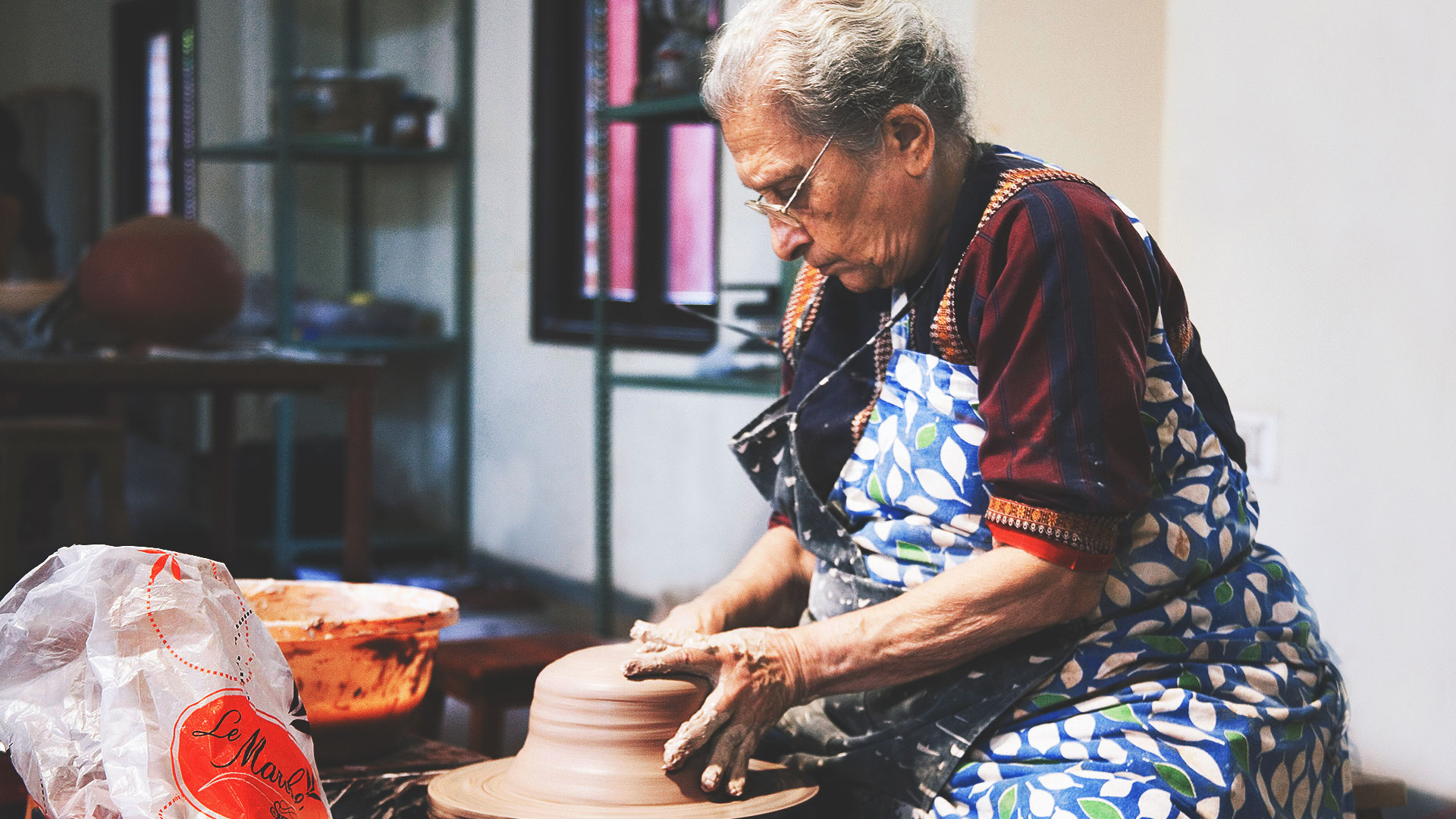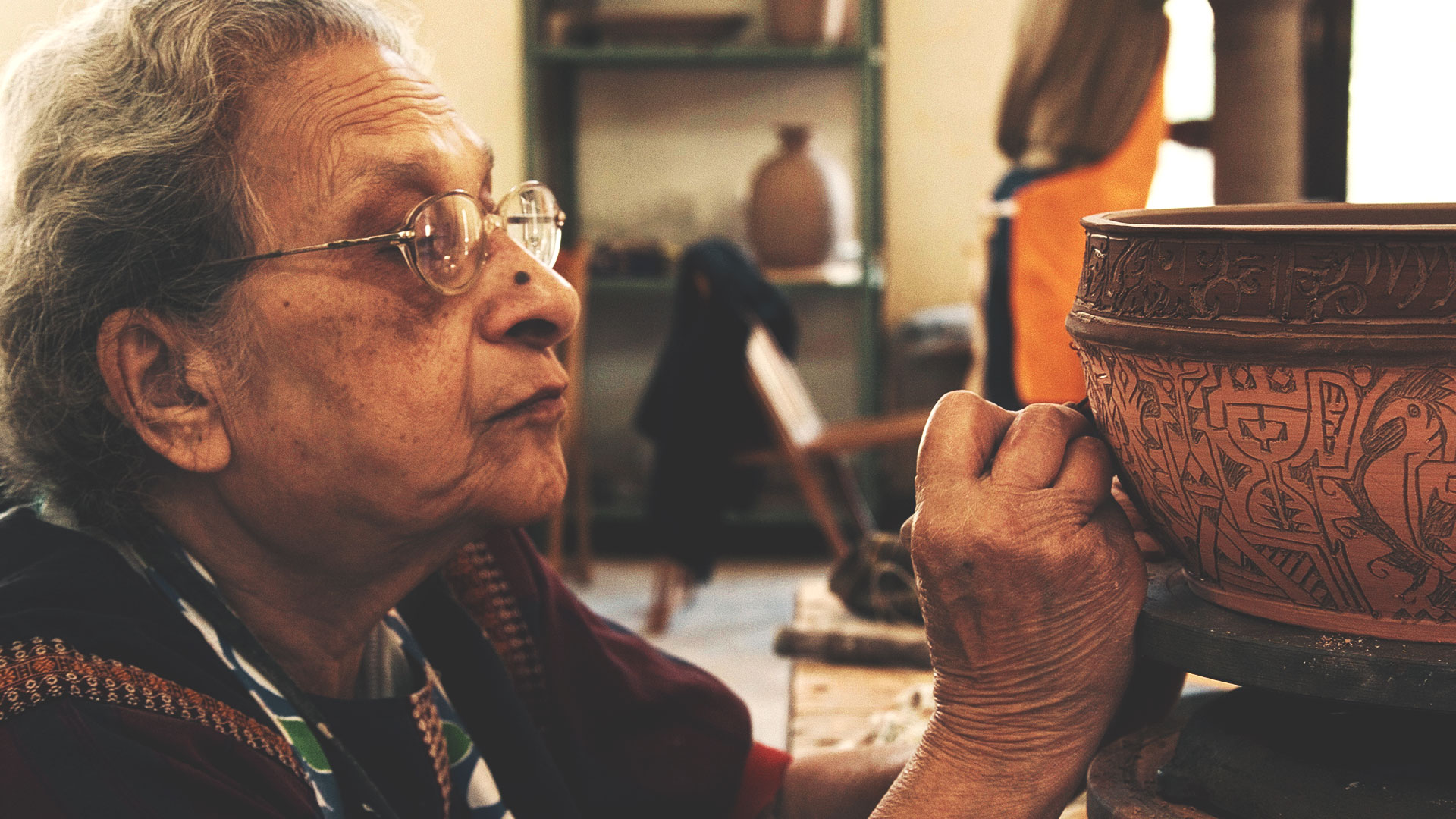An Ira Chaudhuri creation, whatever form it may be, has a strong, robust shape. In the sweep of the lines, the graceful curves, the firm grip, the vitality of the form, her work recalls the verve of the best of the primitive traditions, be it the Harappan terracotta or pre Columbian pottery.
Ira Chaudhuri’s work process has always been a matter of interest and curiosity for everyone, including her students, fellow potters and admirers of her work.
“My goal is a ‘complete pot’. I think of a pot in its final state right from the beginning. I do not believe in throwing pots at random and then sitting down to think what will go on it.”
She has an instinctive and spontaneous way of designing her pots. You won’t see her sketching her design for every pot in the same uniform manner, but she’ll just come up with an impression with a couple of strokes which she might as well have made on a beach or on some rainy day. Then there are times such as the Kolam Design, when Ira Chaudhuri is surrounded by all her armour, like graph paper and scales, which assist her with her work.
“I do not possess extraordinary talent; in fact I am not a good craftsman at all. I don’t have nimble fingers, I am clumsy and untidy and an atrocious thrower. And since I do have average intelligence, I have tried to compensate with my brain what my hands lack.”

Ira Chaudhuri has walked many less trodden roads and stretches, acquainted with many potters and laboured at different places, which gave her a great amount of exposure and inspirations like kolam designs, folk and tribal art, scripts and calligraphy, etc.
If we talk about Tanzania, Ira Chaudhuri went there with Sankho Chaudhuri who was on a teaching assignment. They stayed there for a year. Living on the beach for a year, she was deeply impressed by the shells of starfish, which are somewhat in the shape of a flattened sphere. After Ira’s return to Delhi, she came up with a line of shapes of similar fashion. Each article had a unique proportion, surface treatment, but with the usage of longitudinal and latitudinal lines. This led to a preference for the flattest one and also an element of definite edge.

“I have over the years tried many techniques, stayed with some of them, and I keep repeating them. So many people, in so many places, have practiced pottery over so many years, that there is nothing someone has not attempted. In my early years someone had got some readymade glaze and till they lasted we were glazing merrily and trying ‘creative ways’. I got the brilliant idea of doing Batik, which I had done on cloth only, to find later that wax resist is not unknown to potters. I started to apply clay mixed with oxides and scratched patterns and that of course is Sgraffito. I have gone on doing it and it has almost become a trademark.”
Ira Chaudhuri has always had an inclination towards ceramic chemistry, which led her to formulate her own range of glazes. With the help of her friends in science departments she used to experiment a lot and test them on her pots. This is one of the primary elements which make her pots exclusive.
Ira Chaudhuri’s quality, which is pivotal in a true artist, of letting her knowledge be accessible to everyone is commendable. She is always open to everyone about the formulae of her glazes and her techniques of pottery.
“I am not one of those who can claim that I always nursed a burning desire to become a potter. I had no such intention. Actually it was my husband who pushed me into it. And willy nilly I got hooked. Nor can I propound lofty sentiments like pull of mother earth, an umbilical connection with clay, or a great surge of creativity. For me it is a mundane day-to-day affair, which once in a while serendipity when all the parts fall into place and I get a pot, which really pleases me.
So whenever I am asked to make a short personal statement, my stock answer is ‘I pot, because it bothers me not to. Since I take my work seriously, I do not take myself seriously, and no one else does’.”

